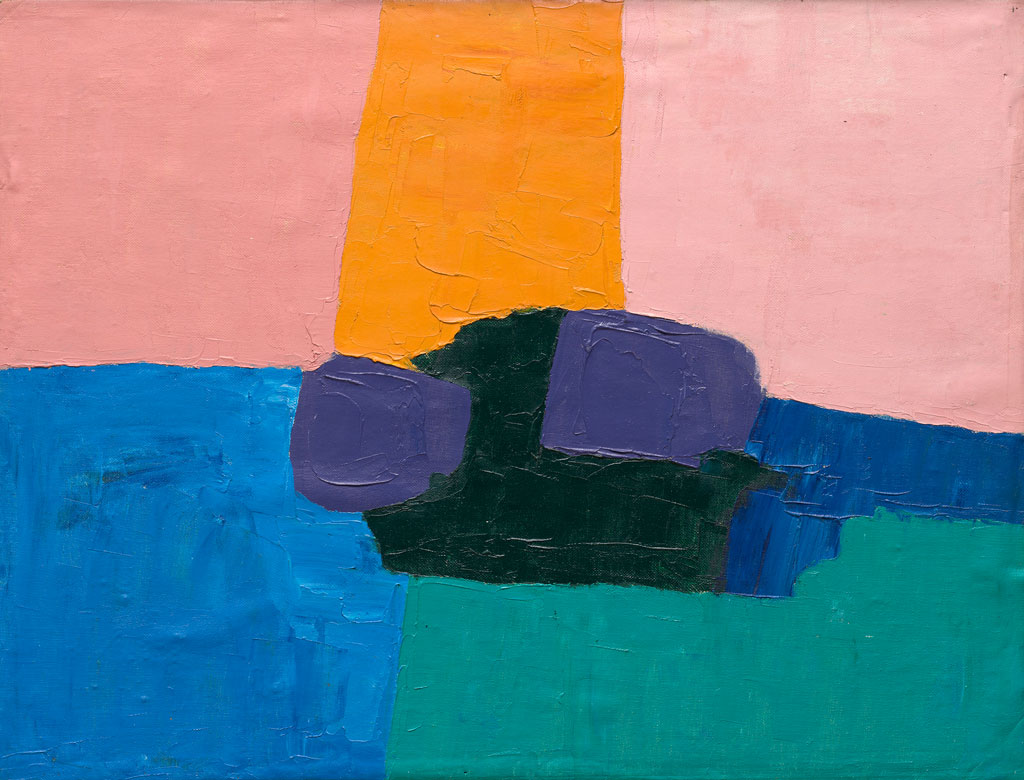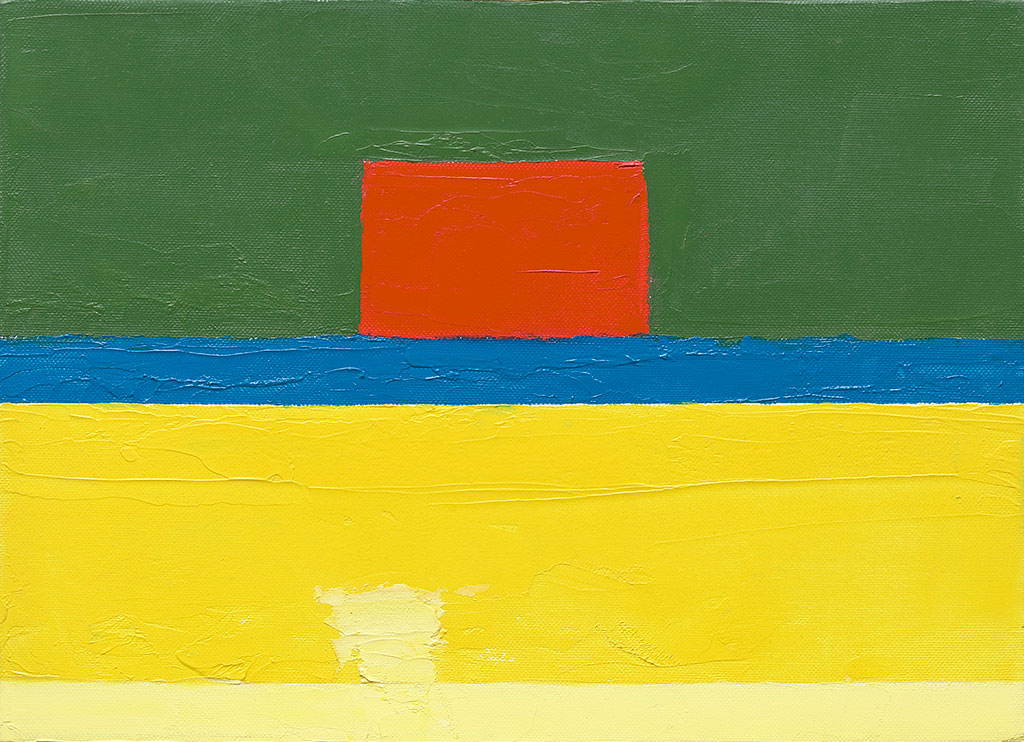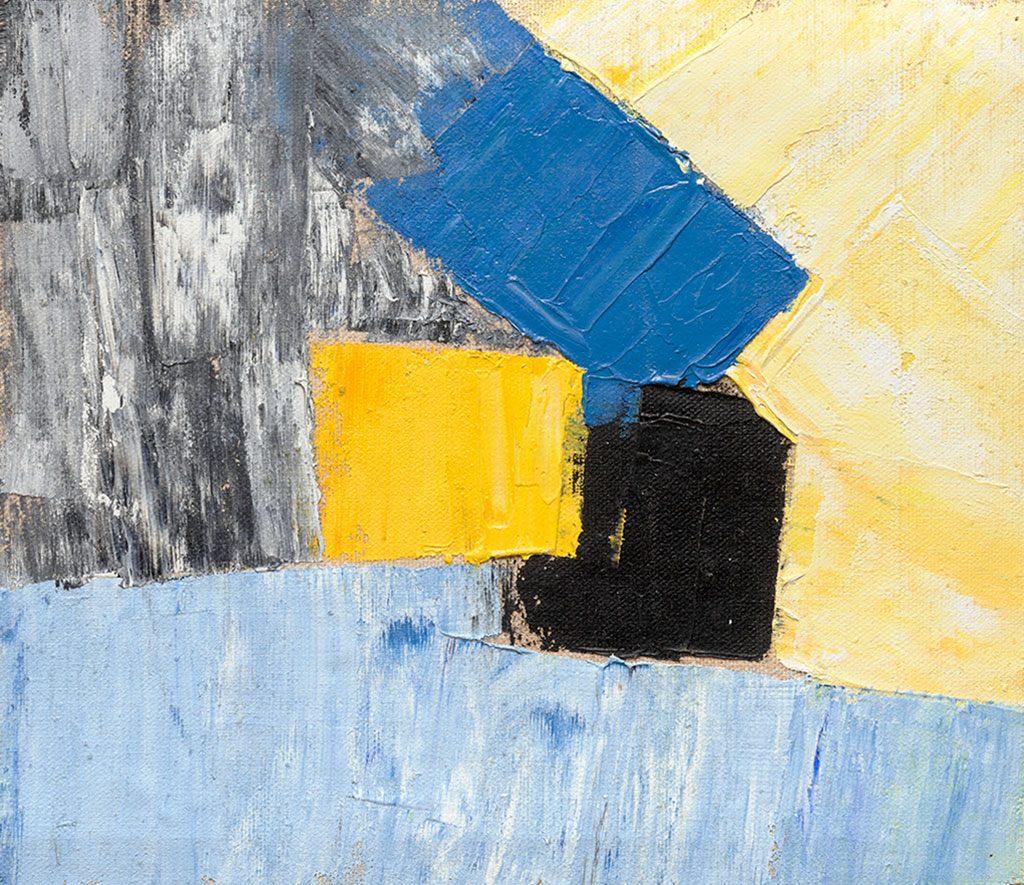Adnan, Etel
1925 – 2021
1925 born in Beirut, Lebanon
1949–1955 studies philosophy in Paris
1955 continues her studies at the University of California, Berkeley and Harvard University, Cambridge, Massachusetts
1958–1972 teaches humanities and philosophy at Dominican College in San Rafael, California
1972 returns to Beirut and works as a features editor for the newspaper Al-Safa
1979 relocates to California
2010 awarded the Lebanese State Prize
2012 participates in dOCUMENTA (13) in Kassel with her own dedicated room
2021 Etel Adnan dies in Paris
Persian, 1963–1964
Öl auf Leinwand
38,5 x 50,5 cm

The Lebanese author and painter Etel Adnan generally worked in small formats, with the canvas lying on the table; instead of a brush, she used a painting knife. Unlike writing, painting is a physical act and a concentrated dialogue between the painter and the world.
Her abstract color compositions depict deserted landscapes reduced to their essential components: mountain and plain, sky and sea, sun and light. Persian (1963–1964), can be read both as a landscape and as a composition of autonomous forms of color. The constellation of large blocks of color invokes sky, sea, and land. A ray of sunlight seems to push its way from above into the center of the composition. The order of this (pictorial) world is a structure of blocks and light, which constantly alters their appearance and colorfulness.
Untitled, 2010/2011
Öl auf Leinwand
25,4 x 35,2 x 2,8 cm
Erworben 2018

In „Untitled“, 2010, dominieren die horizontalen Linien. Ausgehend von dem roten Rechteck gliedern breite und schmalere Farbstreifen die Fläche und wecken Assoziationen an Landschaft. Die beiden unteren Streifen überlagert ein amorpher Fleck: Eine solche „Dialektik zwischen dem fixierten und dem Wandel“ prägt – so die Malerin – viele ihrer Bilder.
Die insgesamt drei kleinen Formate, die sich seit 2018 in der Sammlung der Kunstsammlung Nordrhein-Westfalen befinden bereichern die Sammlung unter mehreren Gesichtspunkten: Sie schlagen Brücken zwischen der Malerei der 1950er Jahre und heute, zwischen Beirut, Paris und der Westküste der USA, und sie ergänzen den Bestand um eine weitere starke weibliche Stimme.
Untitled, ca. 1965-66
Öl auf Leinwand
22,3 x 27 x 0,1 cm
Erworben 2018

Etel Adnan is a “polymath” who lived in many different realms: in the realm of signs and images, as well as in that of words, poetry, philosophy, and political journalism. The daughter of a Greek Christian mother and a Syrian Muslim father from Damascus, she grew up in Beirut, learning French at school and Arabic in the streets of the city. In favor of her love of literature, she accepted a rift with her family, moving to Paris in 1949 and then to California in 1955.
In the untitled painting from circa 1965-66, yellow, blue, and black shapes with irregular contours overlap, each corresponding with larger areas of color opposite them, in which the three colors are now interspersed with white. The materiality of the woven canvas, which frays on the right—much like a carpet—points to the fact that a painting is not only a window to the world, but also an object.
Persian, 1963–1964
Öl auf Leinwand
38,5 x 50,5 cm

Die libanesische Schriftstellerin und Malerin Etel Adnan arbeitet meist im kleinen Format, die Leinwand auf dem Tisch liegend; statt des Pinsels nutzt sie ein Malmesser. Malen ist, anders als das Schreiben, ein physischer Akt und ein konzentrierter Dialog der Malerin mit der Welt.
Ihre abstrakten Farbkompositionen zeigen menschenleere auf ihre wesentlichen Bestandteile reduzierte Landschaften: Berg und Ebene, Himmel und Meer, die Sonne, das Licht. „Persian“, 1963–1964, lässt sich als Landschaft wie als Komposition aus freien Farbformen lesen. Die Konstellation der großen Farbblöcke ruft Himmel, Meer und Land auf. Ein Strahl der Sonne scheint sich von oben ins Zentrum der Komposition zu schieben. Die Ordnung dieser (Bild-)Welt ist ein Gefüge aus Blöcken und aus Licht, das deren Erscheinung und Farbigkeit beständig verändert.
Untitled, 2010/2011
Öl auf Leinwand
25,4 x 35,2 x 2,8 cm
Erworben 2018

In the untitled work from 2010, horizontal lines dominate. Starting from the red rectangle, wider and narrower strips of color divide the surface and evoke associations of a landscape. The two lower strips are superimposed by an amorphous patch: According to the painter herself, such a “dialectic between the fixed and the changing” characterizes many of her paintings.
The altogether three small formats, which entered the collection of the Kunstsammlung Nordrhein-Westfalen in 2018, enrich the museum’s holdings from several points of view: They build a bridge between painting of the 1950s and today, as well as between Beirut, Paris, and the West Coast of the United States. What is more, they add another strong female voice to the collection.
Untitled, ca. 1965-66
Öl auf Leinwand
22,3 x 27 x 0,1 cm
Erworben 2018

Etel Adnan ist eine „Universalgelehrte“, die in vielen verschiedenen Räumen lebt: im Raum der Zeichen und der Bilder ebenso wie in dem der Worte, der Poesie, der Philosophie und des politischen Journalismus. Als Tochter einer griechischen Christin und eines syrischen Muslims aus Damaskus wächst sie in Beirut auf, lernt in der Schule Französisch, in den Straßen der Stadt Arabisch. Für ihre Liebe zur Literatur nimmt sie das Zerwürfnis mit der Familie in Kauf, geht 1949 nach Paris, 1955 nach Kalifornien.
In dem unbetitelten Gemälde von ca. 1965-66 überlagern sich Formen (gelb, blau, schwarz) mit unregelmäßigen Konturen, sie korrespondieren mit jeweils gegenüberliegenden größeren Farbflächen, in denen die drei Farben nun mit Weiß durchzogen sind. Die Materialität der gewebten Leinwand, die rechts – wie ein Teppich – ausfranst, verweist darauf, dass ein Bild nicht nur ein Fenster zur Welt ist, sondern eben auch ein Objekt.
